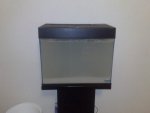KYLZE
New member
- Joined
- Aug 19, 2008
- Messages
- 38
- Reaction score
- 0
- Points
- 0
- Country
- Australia
- Display Name
- KYLZE
Hi,
I bought an albino axolotl 1 month ago. We have a 70L tank. I bought it with everything already setup, eg. Filter, light, etc. However not knowing that they eat small pebbles I bought blue and purple small pebbles like the rocks you see in the bottom of fish tanks. After him living in this for 3 weeks he started eating the pebbles and he's been passing them out the other end, but it looks painful and is obviously not good for him. So after finding info on this site I went and bought white playground sand to replace the rocks with. 2 nights ago we emptied the whole tank out and filled it up with water and then with the sand. (We realised afterwards we should have done the sand first, then the water.) It was so cloudy you couldn't even see 1cm through the water. I left it to settle for 1 hour and then turned the filter on to see if this would clear it up. I cleaned everything in the filter out 3 times over that night and the next day. But the next afternoon it still didn't look much different. So we emptied all the water out again and refilled it. I turned the filter back on 30mins after this time. It's looking better than it was but still very cloudy. I didn't clean the sand, the person at the shop I bought it from told me it was clean. I realise now that I should have done this. But too late. Any advice on how to clean the water would be very very helpful. At the moment Axel is living in a bucket and is doing fine. But I don't want to leave him in there much longer. It's been 3 days in the bucket now, with a water change in the middle of that. Help?!?
I am scared that if I put him in there while it's like this it will hurt him.
Also, there are small bits of what looks like bark in the sand will this hurt him if I don't pick it all out?
Both photo's are 12 hours after we first did it. (Before we emptied it out and replaced all the water.) First one with the light off, second one with the light on. It does look better than this now. But still very cloudy.
Thanks.
I bought an albino axolotl 1 month ago. We have a 70L tank. I bought it with everything already setup, eg. Filter, light, etc. However not knowing that they eat small pebbles I bought blue and purple small pebbles like the rocks you see in the bottom of fish tanks. After him living in this for 3 weeks he started eating the pebbles and he's been passing them out the other end, but it looks painful and is obviously not good for him. So after finding info on this site I went and bought white playground sand to replace the rocks with. 2 nights ago we emptied the whole tank out and filled it up with water and then with the sand. (We realised afterwards we should have done the sand first, then the water.) It was so cloudy you couldn't even see 1cm through the water. I left it to settle for 1 hour and then turned the filter on to see if this would clear it up. I cleaned everything in the filter out 3 times over that night and the next day. But the next afternoon it still didn't look much different. So we emptied all the water out again and refilled it. I turned the filter back on 30mins after this time. It's looking better than it was but still very cloudy. I didn't clean the sand, the person at the shop I bought it from told me it was clean. I realise now that I should have done this. But too late. Any advice on how to clean the water would be very very helpful. At the moment Axel is living in a bucket and is doing fine. But I don't want to leave him in there much longer. It's been 3 days in the bucket now, with a water change in the middle of that. Help?!?
I am scared that if I put him in there while it's like this it will hurt him.
Also, there are small bits of what looks like bark in the sand will this hurt him if I don't pick it all out?
Both photo's are 12 hours after we first did it. (Before we emptied it out and replaced all the water.) First one with the light off, second one with the light on. It does look better than this now. But still very cloudy.
Thanks.
Attachments
Last edited:



